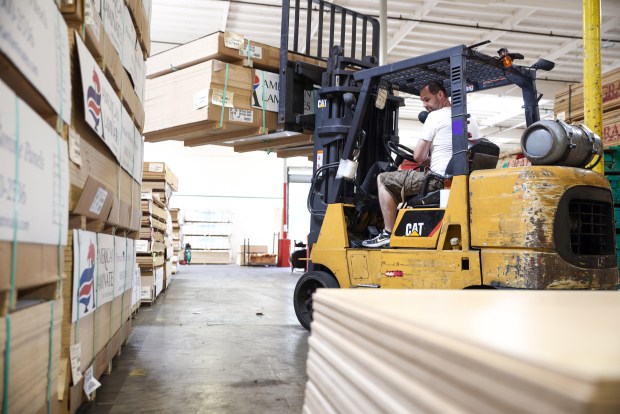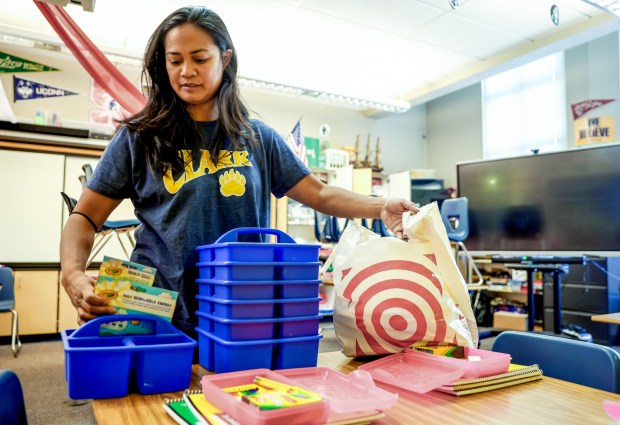You can see it on the faces in the checkout lines, the grimaces at Grocery Outlet, the how-are-we-going-to-afford-this reality checks at Home Depot.
You can hear it in the school supply aisles at Walmart and Target. Four wide-ruled wirebound three-subject notebooks are really 19 dollars? Wait, it’s four bucks more at Amazon?
Thanks to inflation, sticker shock is everywhere in 2022. Whether you’re stocking up for a backyard barbecue or planning to finally finish that deck to do your grilling, even savvy shoppers are feeling the pain.
The per-pound price of ground beef has shot up 52 cents in the last year, or about 12%. Hot dogs? Even worse. They cost nearly 40% more than last year on average. And lumber for your deck? It’s nearly doubled in price.
Yes, prices are higher across the board in the last few months. But does it matter where you shop? We decided to check it out, comparing prices at popular stores for three typical summer shopping lists: your barbecue with the neighbors, building your backyard deck, and the dreaded trip for back-to-school supplies.

Of course, searching for bargains, stocking up on coupons and enrolling in member discounts can make all the difference. So your results may vary.
But we also turned to a few experts and shoppers from the front lines for their advice. Like mom and teacher MaryAnn Cave. You can probably figure out where we met her.
So let’s get to shopping.
Back to school
Between paper and pencils, lunchboxes and clothes that your kids are bound to grow out of, back-to-school shopping lists can go on for pages. We got our list from the Santa Clara Unified School District. Then we met Mrs. Cave and her daughter Mackenzie in the self-checkout lane at a San Jose Target.
By the end of their back-to-school shopping spree, they had successfully tracked down a new school uniform and a haul of notebooks, binders, pencils and highlighters for Mackenzie, who starts her freshman year at Notre Dame High School this month.
On average, families this year will spend $864 on school items, according to the National Retail Federation’s annual back-to-school survey. That’s $168 more than in 2019, before the pandemic.

“No matter where you’re shopping or what you’re shopping for, you can’t really avoid the high prices,” Cave said.
She’s got a point. But in our back-to-school comparison, Target, surprisingly, came in almost $21 cheaper than Walmart and $29 less expensive than Amazon.
While the savings were nothing drastic, the biggest difference came down to one item: the JanSport Big Student Backpack. Target’s was $47.99 — $15 less than Walmart. You can find it even cheaper at JCPenney — their Doorbuster sale knocked the price down to $34.99. Of course, there are cheaper backpacks available at all three stores if you’re willing to scrape for bargains.
Mrs. Cave knows all too well about bargain hunting. Back-to-school is a busy time for her family. In addition to shopping for her two kids, Cave has a fixed budget to buy materials for her fifth-grade classroom at Carolyn A. Clark Elementary in San Jose.
“I’m on a thread right now with other teachers where we are sharing shopping tips and discussing what stores have best deals for each product, from Target to Walmart,” she said.
Her best tip? Plan ahead. At the end of every school year, always keep an eye out for what can be saved and reused the next year. Items such as backpacks and binders, which account for big chunks of back-to-school budgets, often have a life cycle of a few years.
Backyard barbecue
After dragging your kids through the school-supply aisles, you’ve earned some relaxation. In the grocery stores, we found families shopping for movie-night snacks, old friends preparing for their weekly pot roast together, and others filling up their shopping cart for a backyard barbecue.
Surprise, those same burgers that may have taken only $3 worth of ground beef, lettuce, tomato and ketchup a year ago are getting more expensive. Between meat and bread, prices for barbecue supplies have gone up about 10% since last summer, outpacing the annual inflation rate reported this month of 8.5%.
Prices are even soaring for some raw ingredients, a category traditionally more immune to inflation than brand item products — since July, the price of eggs has climbed a towering 33.1% according to the Consumer Price Index report.
The groans are audible in the shopping aisles. No store is a safe haven from high prices for shoppers — “$2.99 for 12 ounces,” bemoaned a shopper as he placed a bag of Brussels sprouts back on the Grocery Outlet shelf. “I can find it cheaper at Safeway.”
Almost no shoppers have been left untouched by inflation’s recent tear. More than 90% of Americans have changed their shopping behavior, according to Denise Dahlhoff, a senior researcher for the Conference Board, a business research group.
When the bills go up, grocery shoppers often revert to a simple philosophy: buy less and buy cheaper. The proof is in the pudding — at Safeway, the shelves of Snack Pack pudding looked nearly untouched. Perhaps shoppers are heeding the tips of experts such as Emily Moquin, a food and beverage analyst at economic-intelligence firm Morning Consult. Cooking from scratch, she said, is usually cheaper than buying packaged or ready-made food.
Buying raw ingredients in bulk can also help soften the blow. When prepping for a barbecue, look for large packages of ground beef or big bags of vegetables. Any burgers and bell peppers you have left over can serve as a meal the next day.

Another option is shopping at liquidation lots such as Grocery Outlet, which absorb extra products from mainstream grocery stores and sell them for less. At bargain stores, you’ll be able to get your Heinz Ketchup for a few bucks cheaper than at Safeway or Whole Foods, and if you don’t mind swapping fresh salmon for frozen, you can save almost $10 per pound.
Even Coca-Cola is cheaper — $8.29 for a 12-pack at Grocery Outlet and $10.43 at Safeway. If you’re willing to sacrifice the name brand, Whole Foods offers their own brand of cola for under $8 per dozen.
Moquin hasn’t seen a notable shift toward budget stores such as Grocery Outlet and FoodMaxx, but “the longer that consumers are feeling the pressure of price increases, the more they may start to evaluate some of those habits in where they’re shopping.”
Our trip to Grocery Outlet left us with a full shopping cart and a bill of $105. That was $25 cheaper than it cost us to shop for a backyard barbecue at Safeway and $50 less than Whole Foods. Granted, we had to check some of the expiration dates on the products.
Home improvement
Where are you going to take back-to-school photos and host your backyard barbecue if not a brand new outdoor deck?
The end of summer has emerged as a uniquely convenient time to whip out the building supplies, as lumber prices come down from historic highs in early 2022. Since March, lumber prices have slipped 30% back to levels last seen in December. Now lumber costs only twice what it did in 2020. What a bargain!
Bay Area lumber yards have started to hear the whir of forklifts and the ring of cash registers pick up again in recent weeks as mainstream demand makes a recovery. The hustle and bustle in the warehouse is a sign that more people are starting building projects.
“At the end of the day, we’re at the mercy of inflation,” said Mike Avery, operations manager for Hardwoods, a San Jose lumber yard. “If the lumber goes up 30%, our prices go up 30%, and obviously that is going to deter some people from buying. There’s nothing we can do about it except wait for prices to come down.”

The worst of the price volatility, Avery hopes, is over. He doesn’t expect prices to decline much further, allowing shoppers to better plan for long-term projects.
Individual shoppers working on DIY projects tend to go to retail stores such as Home Depot or Lowe’s where they can find both lumber and the building materials necessary for a new project. According to Avery, contractors often buy from the lumber yard because it offers lower prices, though the lumber often requires more equipment to cut and prepare the wood.
The price gap varies, impacted by both the type of wood being sold and the yard’s specialization. For a project this size, shopping at the right lumber yard could net you savings up to 10% when compared to retailers, according to quotes from Bay Area lumber yards. That could mean between $50 and $100 back in your wallet for a project like a 12-by-16-foot deck, where lumber typically comprises about 80% of the total cost.
Of course, building a deck requires more than just wood. You’ll need wood screws, joist hangers, outdoor paint and a moisture barrier to safeguard against mold and rot. These items are easiest to locate for comparable prices at stores such as Home Depot and Lowes.
Now that the easy part is over, get ready for the long road ahead. Hopefully the extra cushion in your bank account will comfort you as you deal with temperamental teens, burnt burgers and rickety ramadas. We wish you the best of luck.
Source: www.mercurynews.com
